Jalapeño peppers typically measure between 2,500 and 8,000 Scoville Heat Units (SHU), placing them in the medium heat range on the chili pepper scale. This numerical value represents the concentration of capsaicin, the compound responsible for a pepper's spiciness.
Understanding exactly how many SHU is a jalapeño pepper requires recognizing that heat levels vary significantly based on growing conditions, ripeness, and specific cultivar. While the standard range is 2,500-8,000 SHU, some jalapeños can occasionally reach up to 10,000 SHU under optimal stress conditions.
What the Scoville Scale Measures
The Scoville scale quantifies the pungency (spiciness or heat) of chili peppers by measuring capsaicin concentration in Scoville Heat Units. Developed by pharmacist Wilbur Scoville in 1912, this measurement system remains the standard reference for comparing pepper heat levels today.
Originally determined through human taste testing, modern laboratories now use high-performance liquid chromatography (HPLC) for precise capsaicin measurement, then convert these readings to Scoville units for consumer understanding.
Why Jalapeño Heat Levels Vary
Several factors contribute to the jalapeno pepper heat level measurement variations:
- Water stress - Peppers become hotter when grown with less water
- Ripeness - Red jalapeños (fully ripe) are typically hotter than green ones
- Soil composition - Nutrient levels affect capsaicin production
- Genetic variation - Different jalapeño cultivars have distinct heat profiles
- Seed placement - The placenta (white ribs) surrounding seeds contains the highest capsaicin concentration
| Pepper Type | Scoville Heat Units (SHU) | Heat Comparison |
|---|---|---|
| Bell Pepper | 0 SHU | Mild |
| Jalapeño | 2,500-8,000 SHU | Medium |
| Serrano | 10,000-23,000 SHU | Hot |
| Habanero | 100,000-350,000 SHU | Very Hot |
| Ghost Pepper | 855,000-1,041,427 SHU | Extreme |
Practical Implications of Jalapeño Heat Levels
When working with jalapeños in the kitchen, understanding their scoville scale rating for jalapeno helps manage heat expectations. The middle range of the Scoville scale makes jalapeños versatile for various culinary applications:
Chefs often remove the seeds and white membranes (placenta) to reduce heat while maintaining flavor. For those seeking maximum spiciness, keeping these parts intact delivers the full 8,000 SHU potential. The heat also intensifies when jalapeños are smoked (becoming chipotles), though the SHU measurement remains relatively consistent.

How Jalapeños Compare to Other Common Peppers
Understanding how hot is a jalapeno compared to other peppers provides valuable context for cooking decisions:
- Jalapeños are approximately 2-5 times hotter than poblano peppers
- They're about 8-10 times milder than habaneros
- Compared to serranos, jalapeños are generally 2-3 times milder
- They're significantly milder than ghost peppers (about 100 times less hot)
This moderate heat level explains why jalapeños remain one of the most popular chili peppers worldwide—they provide noticeable heat without overwhelming most palates. Their versatility in salsas, nachos, poppers, and various cuisines stems from this balanced jalapeno scoville units range.

Measuring Heat in Your Own Jalapeños
Home gardeners curious about factors that affect jalapeno spiciness in their own crops can conduct simple tests:
While professional SHU measurement requires laboratory equipment, you can gauge relative heat by comparing small samples to known references. Try tasting a small piece of your jalapeño alongside a commercial one, always starting with the smallest possible amount and having dairy products available to neutralize the heat if needed.
Remember that individual heat perception varies significantly based on genetics and tolerance. What seems moderately hot to one person might feel extremely spicy to another, which is why the standardized SHU measurement exists.
FAQ Section
What is the average SHU for a typical jalapeño?
The average jalapeño measures approximately 5,000 SHU, sitting midway in the standard 2,500-8,000 SHU range. However, individual peppers can fall anywhere within this spectrum based on growing conditions and genetic factors.
Why do some jalapeños taste hotter than others?
Jalapeño heat varies due to environmental stressors like water availability, soil nutrients, and sunlight exposure. The specific plant genetics, ripeness stage (red jalapeños are typically hotter), and which part of the pepper you consume (seeds and membranes contain the most capsaicin) all contribute to perceived heat differences.
How does cooking affect jalapeño heat levels?
Cooking generally preserves jalapeño heat, though prolonged high heat can slightly degrade capsaicin. Roasting or smoking jalapeños (creating chipotles) concentrates flavors but doesn't significantly increase SHU measurements. The perception of heat may change with cooking as flavors meld, but the actual capsaicin content remains relatively stable.
Can you predict a jalapeño's heat by its appearance?
Experienced growers sometimes use visual cues like thin walls, small size, and visible striations (corking) as indicators of higher heat potential. However, these are not reliable predictors—two identical-looking jalapeños from the same plant can have significantly different heat levels. The only accurate measurement requires laboratory testing.
Are there jalapeño varieties with consistent heat levels?
Some cultivated varieties like 'TAM Mild Jalapeño' or 'Jalafuego' have been bred for more consistent heat levels, but natural variation still occurs. Commercial producers often blend peppers from multiple sources to achieve consistent heat profiles in products like canned jalapeños or hot sauces.











 浙公网安备
33010002000092号
浙公网安备
33010002000092号 浙B2-20120091-4
浙B2-20120091-4